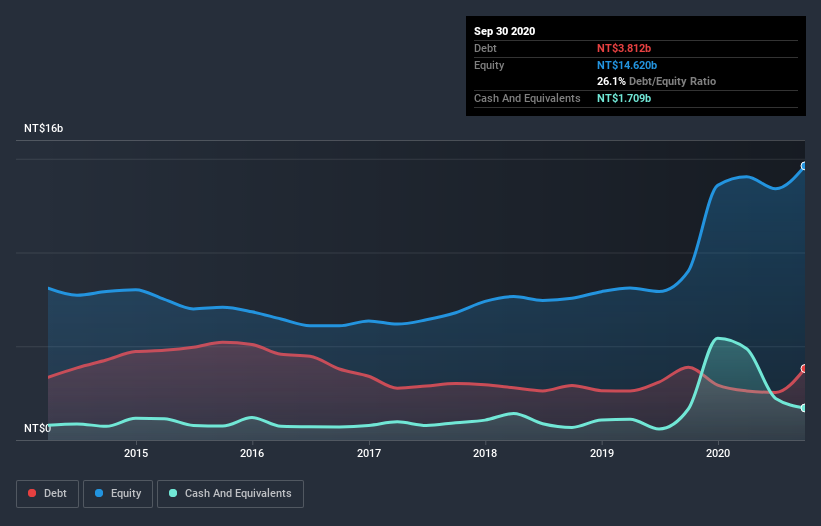- Taiwan
- /
- Electronic Equipment and Components
- /
- TWSE:3406
Genius Electronic Optical (TPE:3406) Seems To Use Debt Quite Sensibly
Warren Buffett famously said, 'Volatility is far from synonymous with risk.' When we think about how risky a company is, we always like to look at its use of debt, since debt overload can lead to ruin. As with many other companies Genius Electronic Optical Co., Ltd. (TPE:3406) makes use of debt. But the real question is whether this debt is making the company risky.
When Is Debt A Problem?
Debt is a tool to help businesses grow, but if a business is incapable of paying off its lenders, then it exists at their mercy. If things get really bad, the lenders can take control of the business. However, a more usual (but still expensive) situation is where a company must dilute shareholders at a cheap share price simply to get debt under control. Of course, debt can be an important tool in businesses, particularly capital heavy businesses. The first thing to do when considering how much debt a business uses is to look at its cash and debt together.
Check out our latest analysis for Genius Electronic Optical
What Is Genius Electronic Optical's Net Debt?
The chart below, which you can click on for greater detail, shows that Genius Electronic Optical had NT$3.81b in debt in September 2020; about the same as the year before. On the flip side, it has NT$1.71b in cash leading to net debt of about NT$2.10b.

How Strong Is Genius Electronic Optical's Balance Sheet?
The latest balance sheet data shows that Genius Electronic Optical had liabilities of NT$5.87b due within a year, and liabilities of NT$3.79b falling due after that. Offsetting this, it had NT$1.71b in cash and NT$4.58b in receivables that were due within 12 months. So its liabilities total NT$3.37b more than the combination of its cash and short-term receivables.
Given Genius Electronic Optical has a market capitalization of NT$52.9b, it's hard to believe these liabilities pose much threat. However, we do think it is worth keeping an eye on its balance sheet strength, as it may change over time.
We measure a company's debt load relative to its earnings power by looking at its net debt divided by its earnings before interest, tax, depreciation, and amortization (EBITDA) and by calculating how easily its earnings before interest and tax (EBIT) cover its interest expense (interest cover). Thus we consider debt relative to earnings both with and without depreciation and amortization expenses.
Genius Electronic Optical's net debt is only 0.35 times its EBITDA. And its EBIT covers its interest expense a whopping 68.5 times over. So we're pretty relaxed about its super-conservative use of debt. In addition to that, we're happy to report that Genius Electronic Optical has boosted its EBIT by 74%, thus reducing the spectre of future debt repayments. The balance sheet is clearly the area to focus on when you are analysing debt. But ultimately the future profitability of the business will decide if Genius Electronic Optical can strengthen its balance sheet over time. So if you're focused on the future you can check out this free report showing analyst profit forecasts.
Finally, while the tax-man may adore accounting profits, lenders only accept cold hard cash. So we always check how much of that EBIT is translated into free cash flow. Looking at the most recent three years, Genius Electronic Optical recorded free cash flow of 29% of its EBIT, which is weaker than we'd expect. That weak cash conversion makes it more difficult to handle indebtedness.
Our View
Genius Electronic Optical's interest cover suggests it can handle its debt as easily as Cristiano Ronaldo could score a goal against an under 14's goalkeeper. But, on a more sombre note, we are a little concerned by its conversion of EBIT to free cash flow. Looking at the bigger picture, we think Genius Electronic Optical's use of debt seems quite reasonable and we're not concerned about it. After all, sensible leverage can boost returns on equity. When analysing debt levels, the balance sheet is the obvious place to start. However, not all investment risk resides within the balance sheet - far from it. For instance, we've identified 1 warning sign for Genius Electronic Optical that you should be aware of.
When all is said and done, sometimes its easier to focus on companies that don't even need debt. Readers can access a list of growth stocks with zero net debt 100% free, right now.
If you’re looking to trade Genius Electronic Optical, open an account with the lowest-cost* platform trusted by professionals, Interactive Brokers. Their clients from over 200 countries and territories trade stocks, options, futures, forex, bonds and funds worldwide from a single integrated account. Promoted
New: Manage All Your Stock Portfolios in One Place
We've created the ultimate portfolio companion for stock investors, and it's free.
• Connect an unlimited number of Portfolios and see your total in one currency
• Be alerted to new Warning Signs or Risks via email or mobile
• Track the Fair Value of your stocks
This article by Simply Wall St is general in nature. It does not constitute a recommendation to buy or sell any stock, and does not take account of your objectives, or your financial situation. We aim to bring you long-term focused analysis driven by fundamental data. Note that our analysis may not factor in the latest price-sensitive company announcements or qualitative material. Simply Wall St has no position in any stocks mentioned.
*Interactive Brokers Rated Lowest Cost Broker by StockBrokers.com Annual Online Review 2020
Have feedback on this article? Concerned about the content? Get in touch with us directly. Alternatively, email editorial-team (at) simplywallst.com.
About TWSE:3406
Genius Electronic OpticalLtd
An investment holding company, engages in the manufacture, processing, and trade of optical instruments, molds, lighting equipment, and related spare parts in Taiwan and China.
Flawless balance sheet and undervalued.
Market Insights
Community Narratives



